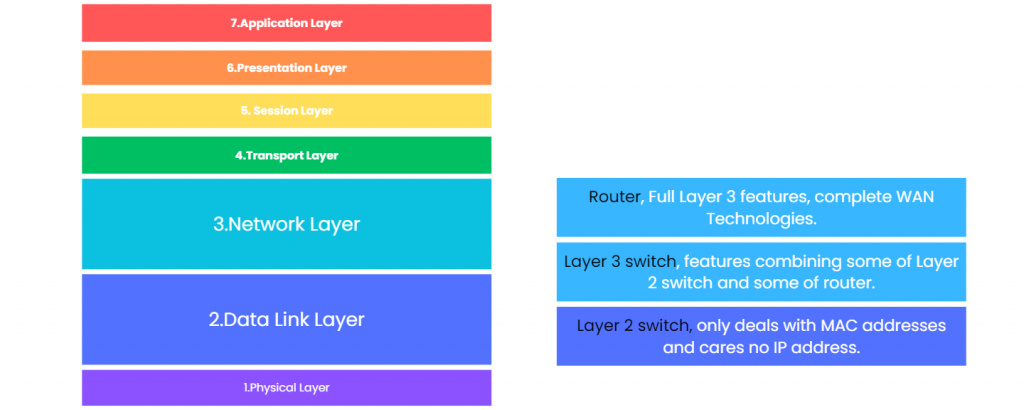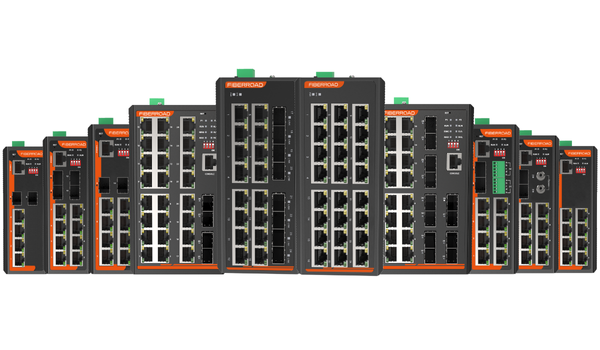Welcome to the world of networking, where every device has a purpose. If you’re new to this scene, don’t worry! Understanding the differences between layer 3 switches and routers might seem like rocket science at first, but we’ve got your back. In this post, we’ll demystify these two devices and help you figure out which one is right for your network needs. So sit tight, grab a cup of coffee (or tea), and let’s dive into the world of layer 3 switches and routers!
What is the Difference Between Layers?
In the world of networking, it’s crucial to understand the concept of layers. Layers are simply a way to organize and categorize different aspects of network communication. The OSI model, which stands for Open Systems Interconnection, defines seven different layers that help define how data moves through a network.
Each layer has its own specific purpose and functionality. For example, layer 1 is responsible for physical transmission while layer 7 handles application-level protocols.
The main reason why we use layers in networking is to make communication more efficient and standardized. By separating out different tasks into distinct layers, we can ensure that each layer only focuses on what it needs to do without interfering with other layers.
Understanding the concept of layers is essential when working with networks since most modern networking devices operate at multiple levels simultaneously.

What is a Layer 3 Switch?
A Layer 3 switch is a type of network switch that can perform routing functions. It operates at the network layer (Layer 3) in the OSI model and uses IP addresses to make routing decisions.
Unlike a traditional switch, which only forwards traffic based on MAC addresses, a Layer 3 switch can route traffic between different VLANs or subnets. This makes it an ideal choice for organizations with complex networks that require more advanced routing capabilities than what a standard router can provide.
One of the key benefits of using a Layer 3 switch is its ability to improve network performance by reducing broadcast traffic. By segmenting the network into smaller subnets and using VLANs, broadcast traffic is contained within each subnet, reducing congestion and improving overall efficiency.
Another advantage of using a Layer 3 switch is its flexibility. With support for multiple protocols such as OSPF and BGP, it can be used in a wide variety of environments including enterprise networks, data centres, and service provider networks.
If you need advanced routing capabilities within your network infrastructure without having to invest in expensive routers or other specialized devices, consider adding one or more Layer 3 switches to your setup.
Taking Networking to the Next Level with Layer 3 Ethernet Switches

1. IEEE 802.3af/at/bt PoE++ Standard, without damaging not-PoE devices. 2. Advanced PoE management functions PoE output setting, Smart PoE, PoE scheduling and PoE Budget Management.

1. IPv4 dynamic routing protocol supports RIPv2 and OSPFv2, IPv6 dynamic routing protocol supports OSPFv3 2. Features IEEE 802.1AS Time Synchronization, IEEE802.1Qbu Frame Preemption, IEEE 802.1Qbv Time Aware Shaper

1. Layer 3 Model support OSPFv2, RIPv2, Static Route Support both IPv4/IPv6 applications 2. LLDP, LLDP-MED protocol suitable for IIoT Applications 3. TACACS+, SNMPv3, IEEE 802.1X, HTTPS and SSH to enhance network security
What is a Router?
A router is a device that connects multiple networks together and forwards data packets between them. It operates at the network layer (Layer 3) of the OSI model and uses routing tables to determine the best path for forwarding packets based on their destination IP address.
Routers are commonly used in homes and businesses to connect local area networks (LANs) to each other or to wide area networks (WANs), such as the Internet. They can also be used to segment larger LANs into smaller subnets, which helps improve network performance and security.
One important function of routers is NAT (Network Address Translation), which allows devices with private IP addresses on a LAN to communicate with devices on the public internet by translating their private IPs into a single public IP. This conserves public IP addresses, which are limited in number.
Another key feature of routers is their ability to implement security measures, such as firewall rules, access control lists (ACLs), and virtual private network (VPN) connections. These features help protect against unauthorized access and attacks from external sources.
Routers play an essential role in modern networking by enabling communication between disparate networks while maintaining security and performance standards.
How do Layer 3 Switches and Routers Work Together?
Layer 3 switches and routers can work together to create a seamless network experience. Layer 3 switches are able to route traffic within the local network, while routers connect different networks together.
When a packet arrives at a layer 3 switch, it is inspected to determine its destination IP address. If that address is located on another device connected to the same network segment as the switch, then the switch forwards the packet directly to that device without involving any other devices like routers.
However, if the destination IP is not located on any of those segments but instead belongs in another network entirely, then this is where routers come into play. The layer 3 switch sends off that packet over to one or more attached router(s) which carry out their routing functionality by forwarding packets between distinct networks according to their specific rules.
By having both layers working together, businesses benefit from increased speed and reliability as well as more efficient use of resources since each device takes care of different tasks depending on its capabilities.
| Feature | Layer 3 Switch | Router |
|---|---|---|
| Scope | LAN for office, Data Center or Campus environment | WAN for Office, Data Center or Campus environment |
| Key Functionality | L3 Switch across different subnets or VLANs on a campus LAN | Routes across different networks across WAN are communicated and Routed by a Router |
| MPLS AND VPN | Does not support MPLS and VPN services | Router provides MPLS and VPN services like PPP etc |
| Edge Technologies Support | Not supported | NAT, firewalling, tunneling, IPsec |
| Size of Routing Table | Smaller Routing table compared to Router | Considerably bigger to support multiple Router entries |
| Fowarding Decision | Forwarding is performed by specialized ASICs | Performed by software |
| Throughput | High Throughput | Layer than Layer 3 Switches |
| Switching Capacity | High Switching Capacity | Lower than Layer 3 Switches |
| Cost | Low Cost | High Cost |
| Port Density | High | Low |
Which One Should I Use?
When it comes to choosing between a layer 3 switch and a router, there are several factors you need to consider. First and foremost, you need to examine the requirements of your network and determine which device best suits those needs.
A layer 3 switch is ideal for networks that require high-speed interconnectivity between subnets. It can handle routing functions with ease while providing fast switching capabilities. On the other hand, routers are better suited for more complex networks that require advanced traffic management features such as Quality of Service (QoS) or Virtual Private Network (VPN).
Another factor you should consider is cost. Layer 3 switches tend to be less expensive than routers and can provide similar functionality in some cases. However, if your network requires advanced routing features, then investing in a router may be necessary.
It’s important to keep scalability in mind when deciding on which device to use. Layer 3 switches offer superior scalability because they can easily add new ports without disrupting existing connections. Routers typically have fixed port counts which limits their expandability.
The decision on whether to use a layer 3 switch or router depends on your specific networking needs and budget constraints.
Conclusion
After examining the differences between Layer 3 switches and routers, it is clear that both devices have their unique advantages and disadvantages. While a router provides more advanced features such as security protocols and wide area network connectivity, a Layer 3 switch offers faster routing speeds for local networks.
When deciding between the two options, it ultimately depends on the specific needs of your network. Consider factors such as size, speed requirements, budget, and desired functionalities before making a decision.
In conclusion, understanding the differences between Layer 3 switches and routers can help you make an informed decision when choosing networking equipment for your organization. Whether you opt for a router or a Layer 3 switch will depend on your individual needs – so choose wisely!






